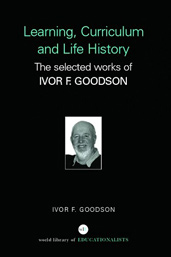Learning, Curriculum and Life Politics: the selected works of Ivor F. Goodson
Long Waves of Educational Reform
Against this conjuncture of change, with financial retrenchment, staff demoralization and turnover linked to standards-based reforms, the case study schools in Ontario echo many of the experiences of the Bradford schools. One of the starkest reminders of the discontinuities between our early conjuncture in the 1960s and 1970s, and the post-1995 conjuncture, is provided by Lord Byron School. One teacher there defines the post 1995 period as one where ‘the creativity is gone’. Byron’s ‘break the mould’ ethos of earlier days has been lost to time. The new staff wrestles with daily survival of preparing three different classes, finding materials and establishing student discipline. The experienced staff juggles an increased workload with demands for curriculum change in a climate of negativity and confusion. This has an overall effect of the reforms on teachers’ sense of mission and meaning. What has changed is how teachers first became part of the Byron staff. Through much of the 1970s and into the 1980s, teachers chose Byron because of its reputation as a creative, innovative place. A few saw it as a 1960s kind of school where you ‘could do your own thing.’ Most people in the late 1980s, however, came to Byron because it had a job that fit their qualifications. In a number of cases they had been in a few schools beforehand and the system had force transferred them to comply with regional seniority rules. Loyalty to the school and its historical image has all but disappeared. Most of the younger people know they will probably be displaced – some are actively looking for different opportunities. These attitudes are strikingly different from the teachers in cohorts one and two who spoke proudly of being a teacher and how Byron had enriched and, in some cases, helped them to refocus their careers and lives.
At Eastside School, a bastion of innovation and cultural change in the 1960s and 1970s, the same transformations noted at Lord Byron are at work, although there is some residual loyalty to the Eastside legacy. While many of the older teachers have retired into second careers, the thousands of new teachers have willingly and enthusiastically entered a tired, battle-scarred environment with larger classes, more preparation, a new rigorous curriculum. The teachers left behind are those who look forward to retirement in the next few years and those who find themselves crushed between the massive exodus of their senior, embittered colleagues and the exuberance and naiveté of the young teachers on staff. This forgotten or ignored middle group of teachers has suddenly aged and finds itself the leaders and mentors of a ‘new’ secondary school system, a role imposed on them by those who have hastily left the profession and those youngsters in their twenties looking to them for support and guidance.
Likewise, the socio-political revolution of the Harris’ Government, with its new centralized reforms of curriculum and assessment, has changed things. The sociopolitical renovation and renewal, including the political turmoil and the economic recession/resurgence of the 90’s has not left Eastside unaffected. While the teachers have remained committed – even sentimentally attached – to the school, its programs and students throughout this decade, the personal and emotional costs have been significant. Teachers, in general and by nature, represent a segment of the population that are rewarded in this chosen vocation by educating, which means the enlightenment, nurturing and caring of students. This seems even more visible in a school where the population is needy in all ways and the teachers are committed to supporting every student to be successful regardless of their background, race, gender, class, sexual orientation, intelligence, and so on. Thus, while the political problems have been evident among teachers across the province, they have impacted deeply on the teachers who teach at Eastside. They are ill at ease with the standardized reforms and want a different kind of change altogether. Their unhappiness with the changes is starkly at odds with the support for change in the 1960s and 1970s.
